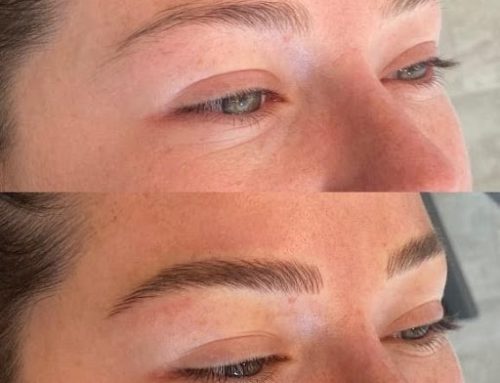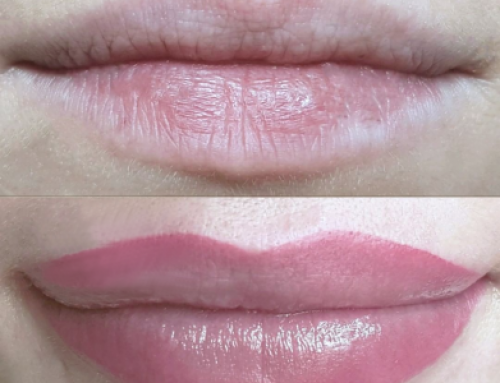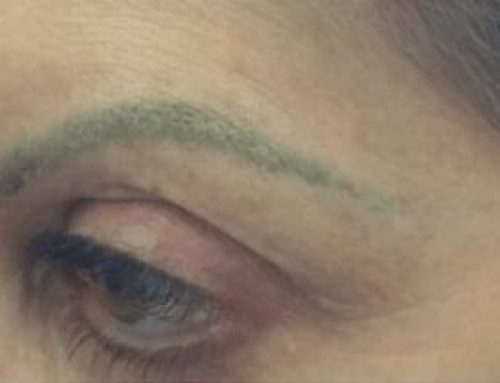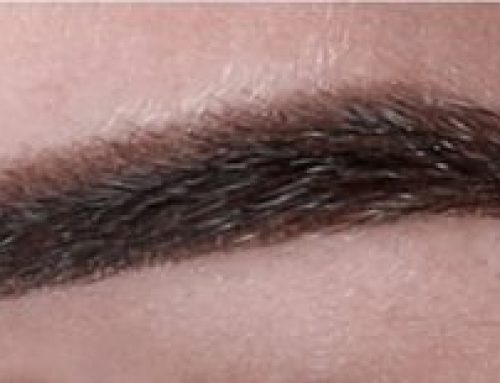Microblading is an updated semi-permanent makeup technique for enhancing the appearance of the eyebrows. It’s the process in which pigment is scratched into your epidermis layer of skin using fine, short strokes resembling hair. Microblading uses a hand-held device with a blade formed of tiny needles.
 It’s also sometimes known as feathering or micro stroking. Unlike a regular tattoo, microblading is a form of tattoo artistry where hair-like strokes made with the tool that will mimic natural hairs in your brows. Even though it’s not as deep as the regular tattoo, it’s still a tattoo because the pigment is implanted under the skin.
It’s also sometimes known as feathering or micro stroking. Unlike a regular tattoo, microblading is a form of tattoo artistry where hair-like strokes made with the tool that will mimic natural hairs in your brows. Even though it’s not as deep as the regular tattoo, it’s still a tattoo because the pigment is implanted under the skin.
Microblading, also known as Eyebrow Embroidery, is a procedure categorized under permanent makeup, but unlike traditional cosmetic tattooing, it is less invasive and is considered semi-permanent. Microblading can dramatically correct or can fully reconstruct lost eyebrows. It’s excellent for those wanting to enhance their brows or who have little to no eyebrows, thinning brows from age or over-tweezed brows. Pigments used are chosen to match the natural or desired brow colors and skin tone.
Microblading has been around for at least 25 years in Asia and Europe. The popularity in the United States has been growing. Microblading typically lasts 1-3 years, depending on skin type and skincare routine. Once applied, the microblading pigment does fade. How long your microblading results last will depend on your skin type, lifestyle, and how often you get touch-ups.
Microblading aims to give you well-defined brows that look natural without the hassle of daily makeup application. The results are very lifelike, giving the eyebrows a natural, fuller look.
How long does microblading take?
Your first microblading session should take about 2.5-3 hours. During this session, the brow technician will shape and style your brows for your approval. The second Microblading session takes place after 4-6 weeks after the initial meeting. It’s known as “a follow-up.” In this session, you will have any minor necessary touch-ups and usually takes approximately 1.5-2 hours to complete.
How much does microblading cost?
Wherever you go for microblading, you’re looking at spending at least several hundred dollars for the procedure. At Wake Up To Makeup Naples, the cost of microblading is $700. The microblading process includes two follow-up appointments. It is performed in a sterile, safe setting by an experienced certified artist. Yearly touch-ups tend to cost about half the cost of the original procedure. For example, touching up a $700 treatment would typically cost around $350.
Microblading isn’t covered by health insurance. There are medical conditions, medications, and treatments that cause your eyebrow hair to fall out. In these circumstances, it never hurts to see if your insurance might consider covering your microblading.
Since microblading can be expensive, ask your artist if you may be eligible for discounts.
Does Microblading Hurt?
Microblading is somewhat uncomfortable and can be painful despite the use of a topical anesthetic. When it’s finished, you’ll have what small cuts on your eyebrow that are no wider than a thread are.
 Before the procedure, your brow technician will apply a topical anesthetic to numb the area, and also reapplied during the process. Everyone responds differently to anesthetic; depending on you, the feeling of the procedure has been described as light cat scratches to not feeling anything. Topical anesthetics used may contain lidocaine, prilocaine, benzocaine, tetracaine, and epinephrine.
Before the procedure, your brow technician will apply a topical anesthetic to numb the area, and also reapplied during the process. Everyone responds differently to anesthetic; depending on you, the feeling of the procedure has been described as light cat scratches to not feeling anything. Topical anesthetics used may contain lidocaine, prilocaine, benzocaine, tetracaine, and epinephrine.
After the procedure, redness and slight swelling in the area are normal. Some describe the area feeling similar to a light sunburn. You can take Tylenol but not aspirin or ibuprofen.
How long does microblading last?
The effects of microblading can last anywhere between 18 and 36 months. Once pigment from the procedure begins to fade noticeably, you’ll need to go back to your practitioner for a touch-up application. Microblading touch-ups are similar to getting root touch-ups for your hair. If you go when your microblading first starts fading, you can have the color filled in. Touch-ups can be necessary every year or year and a half, depending on your skin type and preferred look.
While the results are long-lasting, patients need to understand that microblading is semi-permanent and depends on how well you take care of them. Healthier skin is better able to absorb and retain the pigment used. Smoking cigarettes are also costly as the act both restricts pigment absorption and encourages early fading. If your skin type is oilier, the ink will fade faster and certain medications you may be on like thyroid medications.
How To Make Microblading Results Last Longer
One of the most common ways to sabotage microblading results is not to follow proper post-procedure care. To ensure your brows properly heal:
- Avoid sun exposure while healing.
- For the first ten days post-treatment, no heavy working out or swimming.
- Attend your touch up treatment, usually within six weeks of your initial visit.
- Refrain from wearing makeup over the brows until cleared by your provider.
- Continue waxing every 6-8 weeks to maintain eyebrow shape.
Microblading Healing Schedule
The approximate healing schedule for the microblading procedure will give you a good idea of what to expect in the next few weeks of your permanent makeup healing process.
Day 1… bold color, defined lines, tender, redness. The eyebrow area will be slightly red after the procedure, and the color will appear very dark. This is normal for the procedure and part of the healing process.
Day 2… eyebrows appear very dark and thicker in texture.
Day 3… same as day two but slightly darker. The color will fade by up to 40% as it heals. In the following days, the eyebrows will continue to be dark, and you will notice slight scabbing.
Day 5… eyebrows start to itch.
Day 6-8… skin is starting to flake off and will be itchy. Do not pick at the scabs as this may damage the skin and the outcome of the microbladed area. The eyebrows will lighten up in color as it heals. There is no downtime after the microblading procedure.
Day 9-12… the color appears too light, and spots are missing, strokes may appear blurry.
Day 12-14… color and definition return, and it should look very natural and soft. It takes approximately 7-14 days for the brows to heal over, and about one month for the color to fully set in. You’ll notice the color is very light right after the two weeks after healing; the skin will have an opaque milky looking quality to it. It is known as the milk skin and is common in tattooing. This milk skin is due to the tissue still healing from the inside out even. The actual color will reveal itself once healed.
You should come in for a follow-up visit to have any minor necessary touch-ups. The second Microblading session takes place after 4-6 weeks after the initial appointment. This session will take approximately 1.5-2 hours to complete.
Is the touch-up session necessary?
 Yes! A touch-up session after 4-6 weeks is necessary as everyone heals differently, and the outcome will vary. Certain areas may not retain pigment during the first session and will need to be redone. Pigment color may need to be adjusted; brow thickness and more strokes can be added.
Yes! A touch-up session after 4-6 weeks is necessary as everyone heals differently, and the outcome will vary. Certain areas may not retain pigment during the first session and will need to be redone. Pigment color may need to be adjusted; brow thickness and more strokes can be added.
Individuals with oily skin often require a deeper shade during the touch-up session, as the oils tend to lighten the pigment. Most importantly, your touch up session is when we refine your brows to ensure it looks perfect and retains the color for the whole year!
Can I get my touch up session sooner than four weeks?
Touch up sessions should not be done earlier than four weeks after the initial microblading session, as pigment color has not fully settled into the skin.
Most importantly, this is to prevent scar damage, as the tissue requires time to heal completely.
Microblading is not suitable for the following candidates:
- Using Accutane
- Have heart conditions or using heart medications
- Have diabetes (will require a physician’s note)
- Have skin disease or irritations
- Have had Botox in the last two weeks
- Have gotten a deep tan or chemical peels in the previous two weeks
- Allergic to lidocaine, prilocaine, benzocaine, tetracaine or epinephrine
- Anyone who has any severe medical conditions may require a physician’s note
- Pregnant or nursing clients who want to microblade can be done at your discretion
We suggest discussing it with your doctor first. Microblading is still considered a tattoo, and just like with wine or sushi consumption, it is a personal choice to do so during this period.
We reserve the right to refuse service to anyone who we deem not suitable for this procedure or any other reason. Our brow technicians make the final decision to microblade an individual based on their discretion.
Risks and complications?
We take all proper precautions for a safe session by using sterilized equipment, new needles, and in a sanitized environment. If you follow our pre and post-care instructions, there should be minimal risks or complications. Although allergic reactions to the pigments are rare, it is possible for specific individuals. We suggest a pigment patch test for individuals who have high skin sensitivities or are sensitive to:
- Topical makeup products
- Gold, silver, and nickel
- Hair dyes
Patch tests should be performed 5-7 days prior.
Please keep in mind these kinds of tests are not always conclusive.




